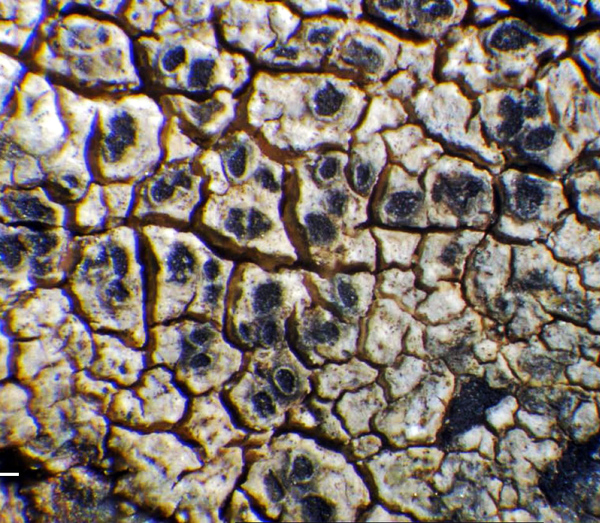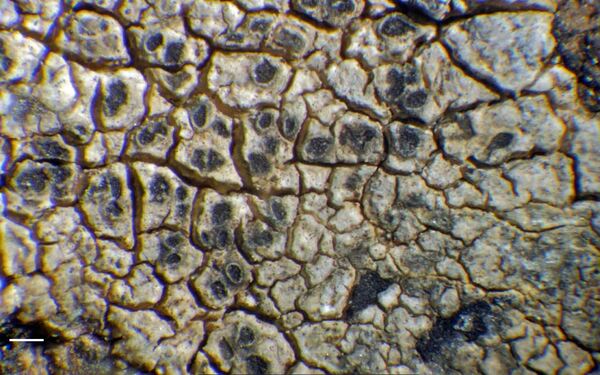Aspicilia prestensis Cl. Roux & Nordin
in Cl. Roux & al., Bull. Soc. linn. Provence, num. spéc. 14: 203, 2011.
Synonyms:
Distribution: N - TAA (Nascimbene 2005, as A. epiglypta).
Description: Thallus crustose, episubstratic, 0.2-0.5 mm thick, areolate or rimose-areolate, whitish to pale ash-grey, forming 2-7 cm wide patches, sometimes delimited by a dark prothallus. Areoles angular, 0.3-2.4 mm wide, the peripheral ones often larger. Cortex colourless, filled by brownish crystals insoluble in N but soluble in K, overlain by a thin epinecral layer, that of the apothecial margins usually brown (Subdepressa-brown pigment, K-, disappearing in N); medulla white, with large crystals, I-. Apothecia lecanorine-aspicilioid, 0.15-0.9 mm across, usually round, immersed in the areoles, 1-5(-15) per areole, with a black, epruinose, concave to flat, finely rugose, sometimes umbonate disc, and a thin thalline margin, often with a darker annular zone. Epithecium greenish brown, 8-15(-25) μm high, N+ emerald green; hymenium colourless, 75-115 μm high, I+ blue turning brownish red; paraphyses non moniliform, 1-1.5 μm thick at base, not moniliform, progressively widening upwards to c. 4 μm; hypothecium colourless, 35-60 μm high, I+ pale blue, then yellowish red. Asci 8-spored, the thin outer coat K/I+ blue, the wall and apical dome K/I-, with biseriately arranged spores. Ascospores 1-celled, hyaline, ellipsoid, (12-)17-24(-27.5) x (7-)9.5-14(15.5) μm. Pycnidia subglobose or ovoid, the wall colourless except in the brownish green upper part. Conidia thread-like, straight or slightly curved, (10.5-)14-21(-25) x c. 1 μm. Photobiont chlorococcoid. Spot tests: cortex and medulla K+ yellow turning red (needle-like crystals), very rarely K+ persistently yellow, C-, KC-, P+ yellow-orange. Chemistry: norstictic acid, very rarely with stictic acid as the major substance.Note: a species with an areolate, non-effigurate, whitish-grey thallus reacting K+ red, often confused with A. cinerea (with smaller ascospores) and A. epiglypta (with rough apothecial discs); it grows on acidic rocks, with optimum in sunny places, near and above treeline. According to Roux & al. (2011) A. epiglypta is restricted to coastal areas in northern Europe, and records from elsewhere may be due to confusion with other species, especially with A. prestensis. Pending a revision of the whole complex in Italy, I attribute here the record of A. epiglypta from South Tyrol to A. prestensis. See also note on A. cinerea.
Growth form: Crustose
Substrata: rocks
Photobiont: green algae other than Trentepohlia
Reproductive strategy: mainly sexual
Poorly known taxon in need of further study
Commonnes-rarity: (info)
Alpine belt: rather rare
Subalpine belt: rather rare
Oromediterranean belt: rather rare
Montane belt: very rare
Submediterranean belt: absent
Padanian area: absent
Humid submediterranean belt: absent
Humid mediterranean belt: absent
Dry mediterranean belt: absent

Predictive model
Growth form: Crustose
Substrata: rocks
Photobiont: green algae other than Trentepohlia
Reproductive strategy: mainly sexual
Poorly known taxon in need of further study
Commonnes-rarity: (info)
Alpine belt: rather rare
Subalpine belt: rather rare
Oromediterranean belt: rather rare
Montane belt: very rare
Submediterranean belt: absent
Padanian area: absent
Humid submediterranean belt: absent
Humid mediterranean belt: absent
Dry mediterranean belt: absent

Predictive model
 INDEX FUNGORUM
INDEX FUNGORUM
 GBIF
GBIF
 DOLICHENS
DOLICHENS



